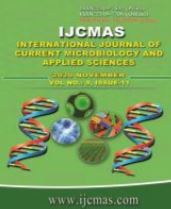


 National Academy of Agricultural Sciences (NAAS)
National Academy of Agricultural Sciences (NAAS)

|
PRINT ISSN : 2319-7692
Online ISSN : 2319-7706 Issues : 12 per year Publisher : Excellent Publishers Email : editorijcmas@gmail.com / submit@ijcmas.com Editor-in-chief: Dr.M.Prakash Index Copernicus ICV 2018: 95.39 NAAS RATING 2020: 5.38 |
Field experiments were conducted during rabi season of 2018-19 and 2019-20 at ANGRAU, Regional Agricultural Research Station, Nandyal, to study the weather related information on chickpea (Cicer arietinum L.) growth and yield under crop residue incorporation, varied time of sowing and irrigation stages. Results revealed that the mean values of weather indices like accumulated growing degree day, helio thermal units, photo thermal units at different phenophases and thermal use efficiency were influenced by times of sowing but not with crop residues incorporation and irrigation. Time of sowing also did not influence the days to reach different phenophases from emergence to harvest significantly. However, the first and second dates of sowing recorded more number of days to reach 50 per cent flowering, physiological maturity and harvest stage. Growing degree days, helio thermal units, photo thermal units, at flowering, physiological maturity and harvesting maturity of crop found to be highest in October second fortnight sown crop and goes on decreased with delay in sowing with fortnight interval, up to December first fort night. The drymatter and seed yield were higher with November first fortnight sown crop drymatter production (4719 kg ha-1), seed yield (1660 kg ha-1). The study concludes that maximum seed yield of chickpea can be achieved when chickpea was sown during November 1st FN, with incorporation of foxtail millet crop residue with two irrigations, one at pre flowering and another at pod development stage, attributed to record the higher thermal use efficiency (TUE) (dry matter 2.25 kg ha -1 0C day and seed 0.77 kg ha -1 0C day) under SRZ of Andhra Pradesh.
 |
 |
 |
 |
 |